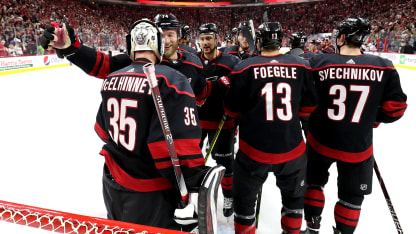Unlike many teams, the Hurricanes dominate shot attempts regardless of the score, showing a clear tendency to keep up the pressure, even when leading. When they've been ahead in the postseason, they have controlled 55.61 percent of the 5-on-5 shot attempts, which is unusual. In general, the tendency is for the trailing team to generate more shots since the team protecting the lead usually tightens up defensively.
The St. Louis Blues (51.22 percent) are the only other playoff team with more than 50 percent of shot attempts while leading. This dominance has not been achieved by accident. The Hurricanes are built on players who have been on the positive side of attempted-shot counts throughout their NHL careers.
Captain Justin Williams has a clutch reputation as "Mr. Game 7," but he has been an analytics superstar from the time shot-based advanced stats became public. Since 2009-2010, Patrice Bergeron (58.07) of the Bruins and Pavel Datsyuk (57.74) are the only players with better SAT percentages than Williams (57.32). This is remarkable considering that Williams is earning dominant shot differentials and the time frame measures his performance from age 28 through 37, seasons that statistically are generally considered past the prime for most players.
The other veteran who anchors the Hurricanes' puck possession game is Jordan Staal, who led the NHL with a 59.69 shot attempt percentage this season. The center does this despite being tasked with the heavy lifting for Carolina, starting more of his shifts in the defensive zone (50.31 percent) and getting matchups against the opposition's top lines. Given those circumstances, it's incredible that Staal still drives play so effectively.
With those two veterans as anchors, the Hurricanes have steadily augmented the group. They acquired defenseman Dougie Hamilton in a trade with the Calgary Flames at the 2018 NHL Draft. Though Hamilton is in the spotlight because he leads all defensemen with 35 goals the past two seasons, he's also been among the very best when it comes to relative shot attempt percentage since 2014-2015. Mark Giordano (5.30) is the only defenseman with a better
cumulative relative shot attempt percentage
in the past five seasons than Hamilton (5.10), with a minimum of 350 games played.
The Hurricanes also acquired forward Nino Niederreiter in a trade with the Minnesota Wild for forward Victor Rask on Jan. 17. Niederreiter excels in terms of driving play. Since 2015-2016, he has the best relative shot attempt percentage (7.09) in the NHL. Adding players with a pedigree of being on the right side of shot attempts builds on the Hurricanes' foundation.
There is no guarantee that winning the battle of shot attempts is going to result in victory, but it's been the path to success for the Hurricanes because once they established that they could consistently outshoot the opposition, then it was a matter of percentages falling in line.
Through the end of December, the Hurricanes were shooting an NHL-worst 5.5 percent during 5-on-5 play, so they weren't in the playoff picture at 16-17-5. After Jan. 1, they shot 8.8 percent and went 30-12-2. In the playoffs, the Hurricanes have continued that second-half surge, shooting 8.6 percent during 5-on-5 play, the best rate among teams in the postseason.
The other side of percentages is related to goaltending and Carolina has improved there too. Through Dec. 31, Hurricanes goalies had a .916 5-on-5 save percentage, which was slightly below League average, but Petr Mrazek emerged as a force down the stretch and the Hurricanes had a .925 save percentage during 5-on-5 play after Jan. 1. The goaltending has been even better in the postseason with a .940 save percentage at 5-on-5 through two rounds.
The question now is whether the Hurricanes can keep this run going against the Bruins, a team that has historically been able to count on outshooting the opposition. In the past five seasons, Boston ranks second in shot attempt percentage (52.76) and Carolina
is fourth
(52.48), so the Hurricanes could face a stiff test when it comes to controlling play in the Eastern Conference Final.
---
Listen: New episode of NHL Fantasy on Ice podcast

